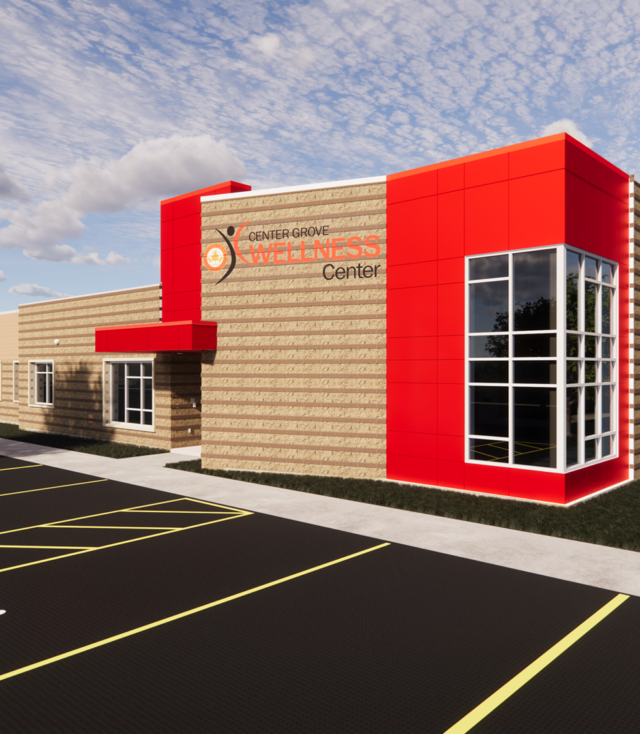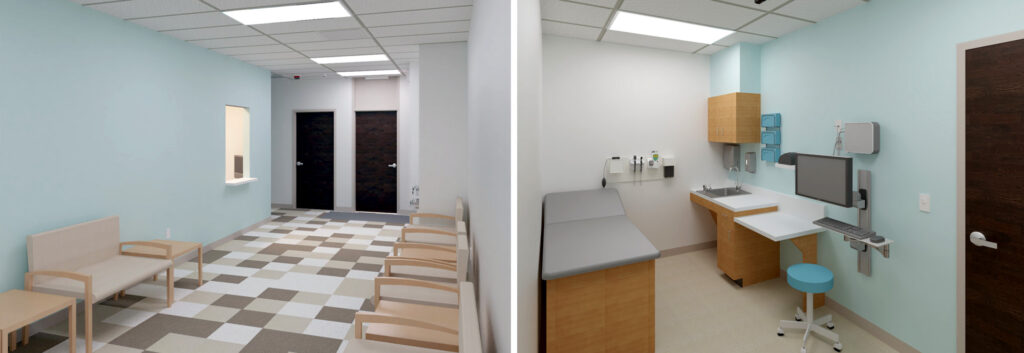Insights
Designing School-Based Health Centers
By Dan Obrynba
School-based health centers are becoming integral components of public schools, primarily serving the needs of students and staff, with the potential to also serve the broader community. School-Based Health Centers are usually run by separate healthcare providers and offer a range of services within the school premises, from primary care, dental and vision exam rooms to mental health support. These facilities are particularly effective at reducing the amount of instructional time missed by teachers and students. As school administrators prepare to incorporate school-based health centers into their buildings, several essential design practices and collaboration strategies must be considered.
Design Best Practices
- Separate Secure Entrances: It is recommended the entrance is recognizable, distinct and has a secure entrance with access control. This facilitates separate operating hours and ensures privacy and safety for individuals utilizing the facility. If the facility is open to the public, that entrance should go directly into the health center, not through the school.
- Operational Efficiency: During design, operational efficiency should always be considered. Understanding how the medical staff interact with the patients and configuring spaces to effectively support their practice helps to streamline the health center operations.
- Infrastructure Upgrades: Renovating existing spaces for health centers often requires significant infrastructure upgrades, including HVAC electrical, plumbing improvements as well as fire alarm and security system upgrades to meet code requirements and occupant comfort.
Aligning School and Healthcare Provider Needs
Collaboration between school districts and healthcare providers is key to designing effective school-based health centers. Understanding and integrating the needs of both parties ensures functional and cohesive spaces.
For example, Fanning Howey collaborated with Mount Vernon City Schools to convert 4,200 SF of a former industrial arts department in Mount Vernon High School into a school-based health center which is now operated by Nationwide Children’s Hospital. As part of the agreement, the Hospital had a standardized program of spaces for the five exam rooms to be located within the building. The design team created multiple conceptual solutions to model ideal configurations to accommodate this space program in the most effective way. Our interactive design process led to the expansion of the original program to include essential elements such as a staff and student restroom. Since the opening of the school-based health center, we are pleased to say we have received many positive reports regarding the success of the new facility.
In cases involving multiple healthcare providers, such as separate providers for dental and vision services, the design team plays a crucial role in harmonizing requirements. By facilitating open communication, a cohesive design approach is achieved, ensuring seamless operation of diverse healthcare services within the school environment.

Finding the Right Space
The location of a school-based health center is one of the earliest decisions an owner needs to make. Fanning Howey has helped clients integrate health centers within existing buildings, establish free-standing health centers located on school property and convert former public libraries into health centers. Where the health center is located has a significant impact on the overall budget and long-term functionality, so our design teams provide a range of options that let school districts make the best possible decisions.

Conclusion
As school administrators embark on integrating health centers into their facilities, adherence to design best practices and effective collaboration are paramount. By aligning the needs of school districts and healthcare providers, school-based health centers serve as invaluable assets, promoting the well-being of students, staff and the wider community.
The Psychology of Interior Design: Creating Spaces That Shape Learning
By Morgan HemmingsWhen people think about school design, their minds often go to the big moves – gymnasiums, auditoriums, state-of-the-art labs. But to me, some of the most powerful transformations happen in the spaces in between. Interior
Full ArticleCreating Ideal Montessori School Environments: A Guide for Architects and Educators
By Carla RemenschneiderMontessori schools are designed to foster independent learning, exploration and creativity in children. As an architecture, interiors and engineering firm, Fanning Howey understands the importance of designing physical spaces that support these principles. By thoughtfully
Full ArticleEsports Facilities for Student Engagement
By Steven HerrAs competitive esports becomes a viable career path, educators across the country are embracing these gaming trends and expanding esports programming at their schools. Schools that have adopted esports are already seeing the benefits. According
Full Article